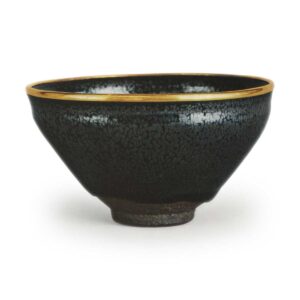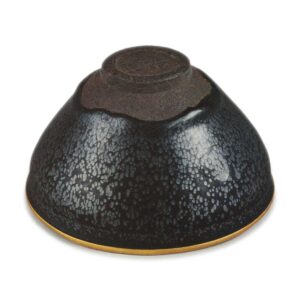

Daimyo’s treasure
National Treasure
Height: 6.8-7.0cm
Diameter: 12.3 cm
Foot diameter: 4.3cm
Height: 0.7cm
One of the entries in the “Kundai Kansuicho Ki” (a record of the tea ceremony) says, “The Yudeki is second only to the Yohen… the Yohen is not to be outdone by the Yudeki,” and this is indeed a rare and exquisite example of the Yudeki, and a highly esteemed and elegant tea bowl with a long history.
The shape is a typical Kenryo shape, with the mouth firmly twisted back, and the foot is low, with the inside of the foot shallowly and flatly scooped out to create a “snake’s eye” shape. The inside and outside are covered in black glaze, and countless silver-colored oil spots can be seen on this. The glaze is scraped off around the waist on the outside, and the rest of the piece is exposed.
The unglazed part of the body is made from a slightly coarse clay that contains a lot of iron, and it is fired hard to produce a dark grayish brown color. The glaze flows and becomes thin under the rim, and it takes on a reddish hue, with fine oil droplets scattered across it. In the area where the glaze has run off the waist, a thick glaze pool has formed, and the oil droplets have flowed into this area, creating a grainy effect. The lower edge of the glaze pool has been repaired in several places, and this is probably because the glaze drips were polished at some point.
The oil drops are almost completely filled in, both inside and out, and the black glaze outlining them is only faintly visible in places, forming thin lines. The oil drops are irregularly shaped, with the thin lines of the outlines forming a kind of mysterious pattern. The silver-colored oil drops have a slight bluish tinge, creating an attractive appearance. The beauty of the interior is particularly exceptional, with a rainbow-like band shining from a light purple to a light blue-indigo color in the middle, creating a unique and noble flavor.
There is a gold border around the rim.
This is the most famous of the Yudeki Tenmoku tea bowls, and is thought to have been made at the Jian kilns in Fujian Province, China, around the 13th century. It is not clear when it came to Japan, but it is thought to have arrived at the end of the Kamakura period or the beginning of the Muromachi period.
It was originally owned by the former regent Hujii, and was considered to be one of the Jyuraku utensils, but later it was moved to the Nishi Honganji temple, and then to the Mitsui family in Kyoto’s Rokkaku district. It was later acquired by the Sakai family, the feudal lords of Wakasa, and is now in their possession. It was designated a new national treasure in 1953.
The set includes one white habutae cloth covering, one black lacquered box with a lock, two replacement covers, and three tenmoku stands. One of these is a red lacquer chrysanthemum-shaped tenmoku stand that was owned by Kobori Enshu and is said to have been used by the Mitsui family. The other two are called Wakasa stands, with red lacquer on the inside and blue lacquer on the outside, and one of these is said to have been owned by Arima Ryōki.



